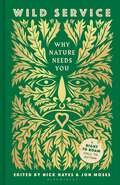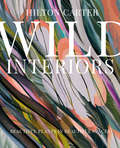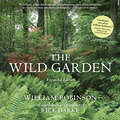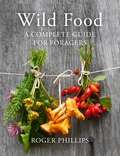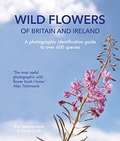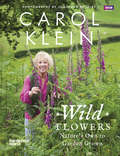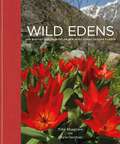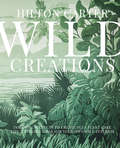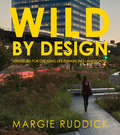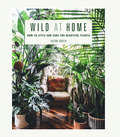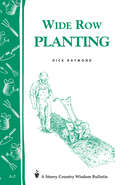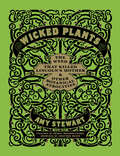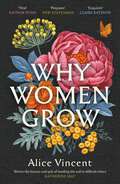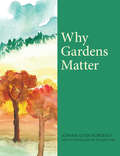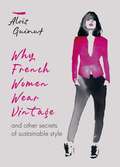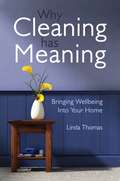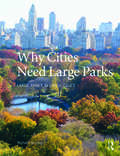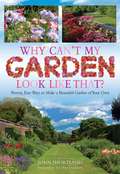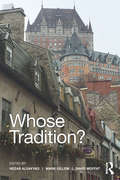- Table View
- List View
Wild Service: Why Nature Needs You
by Nick Hayes'A reckoning with our past and a vision for a new ecological future' Amy-Jane Beer 'Seeks to undo the damage of exclusionary ownership through the transformative power of belonging' Guy Shrubsole In May 2022, the Royal Swedish Academy of Sciences released a paper that measured fourteen European countries on three factors: biodiversity, wellbeing, and nature connectedness. Britain came last in every single category. The findings are clear. We are suffering, and nature is too.Enter 'Wild Service' – a visionary concept crafted by the pioneers of the Right to Roam campaign, which argues that humanity's loss and nature's need are two sides of the same story. Blending science, nature writing and indigenous philosophy, this groundbreaking book calls for mass reconnection to the land and a commitment to its restoration.In Wild Service we meet Britain's new nature defenders: an anarchic cast of guerilla guardians who neither own the places they protect, nor the permission to restore them. Still, they're doing it anyway. This book is a celebration of their spirit and a call for you to join. So, whether you live in the countryside or the city, want to protect your local river or save our native flora, this is your invitation to rediscover the power in participation – the sacred in your service.
Wild Service: Why Nature Needs You
by Nick Hayes'A reckoning with our past and a vision for a new ecological future' Amy-Jane Beer 'Seeks to undo the damage of exclusionary ownership through the transformative power of belonging' Guy Shrubsole In May 2022, the Royal Swedish Academy of Sciences released a paper that measured fourteen European countries on three factors: biodiversity, wellbeing, and nature connectedness. Britain came last in every single category. The findings are clear. We are suffering, and nature is too.Enter 'Wild Service' – a visionary concept crafted by the pioneers of the Right to Roam campaign, which argues that humanity's loss and nature's need are two sides of the same story. Blending science, nature writing and indigenous philosophy, this groundbreaking book calls for mass reconnection to the land and a commitment to its restoration.In Wild Service we meet Britain's new nature defenders: an anarchic cast of guerilla guardians who neither own the places they protect, nor the permission to restore them. Still, they're doing it anyway. This book is a celebration of their spirit and a call for you to join. So, whether you live in the countryside or the city, want to protect your local river or save our native flora, this is your invitation to rediscover the power in participation – the sacred in your service.
Wild Interiors: Beautiful plants in beautiful spaces
by Hilton Carter“We work with Hilton because he’s both a plant stylist and an incredible plant-care wizard. Hilton doesn’t just teach you how to get your plants to thrive – he teaches you how to bond with them.” - Apartment TherapyBestselling author Hilton Carter brings his unique eye and love of plants to show you how to create luscious interiors that not only look amazing but are good for your well-being, too. Hilton first guides you through his own plant journey, his inspirations, and his top ten favourite house plants. He then takes you on a Journey in Greenery where he showcases the homes of 12 inspiring plant parents that demonstrate the versatility of decorating with plants. From a tiny house in Venice, California and a light-filled loft in New York City, to a Berlin apartment decorated with vintage finds, and the Barcelona home of a ceramic artist, there are ideas for all types of spaces and budgets. Hilton then sets you off on your very own plant journey, taking you room by room, profiling the plants that are most suited to each: those that thrive in the tropical humidity of bathrooms, the erratic heat changes of kitchens and plants that can live happily in the indirect light of an entryway or bedroom. Packed full of interior design advice such as using ‘statement plants’ like Fiddle-leaf figs to create a focal point, how to layer your greenery by using hanging baskets, and how to assemble the perfect plant shelf, Hilton shows you how bringing houseplants into your home creates instant impact. Be inspired to create your own Wild Interiors with Hilton’s expert styling advice, plus his hints and tips on plant care that take the mystery out of looking after your green friends.
The Wild Garden: Expanded Edition
by William RobinsonA rich combination of original text, modern commentary, and lush photography makes this new edition essential reading for anyone who wants to understand how we have arrived at our present assumptions about gardening and where we still need to go.
Wild Food: A Complete Guide for Foragers
by Roger Phillips'I can safely say that if I hadn't picked up this book some twenty years ago I wouldn't have eaten as well, or even lived as well, as I have. It inspired me then and it inspires me now' Hugh Fearnley-WhittingstalWild food is all around us, growing in our hedgerows and fields, along river banks and seashores, even on inhospitable moorland. In Roger Phillips and Martyn Rix's Wild Food, hundreds of these plants are clearly identified, with colour photography and a detailed description. This definitive guide also gives us fascinating information on how our ancestors would have used the plant as well as including over 100 more modern recipes for delicious food and drinks. From berries, herbs and mushrooms to wild vegetables, salad leaves, seaweed and even bark, this book will inspire you to start cooking with nature's free bounty.
Wild Flowers of Britain and Ireland: A Photographic Identification Guide To Over 600 Species
by Rae Spencer Jones Sarah CuttleThe close-up photographs allow you to examine each plant in detail - so you will know your English from your Spanish bluebell - and because it is done by colour instead of name, it is much easier to navigate.Full of fascinating information, including where and when you will find the flowers, their characteristics, and anecdotes on their historical background with their medicinal and culinary uses. You don't even need to go out into the field to enjoy these beautiful and sometimes elusive flowers.
Wild Flowers: Nature's own to garden grown
by Carol KleinWild flowers are a great passion for Carol, and for the TV show this year she’s travelling the length and breadth of the country to find the most exquisite flora occurring naturally in our woodlands, hedgerows, meadows and moors, and then she sets off in search of their cultivated cousins, and shows us how to grow them in our own gardens. In her accompanying book, Carol delves into the story of each plant, full of myth, legend and country lore, and as always shares her practical expertise, passing on hints and tips, including which variations to go for, how and where to plant, and what with, for the most spectacular results.Containing thirty two of Britain's favourite wild flowers and their home-grown descendents, structured by season and illustrated with Jonathan Buckley’s amazing photographs, this book of botanical wonders will inspire, surprise and inform gardeners of all levels.
Wild Edens
by Chris Gardner Toby MusgraveExplore the world through a horticultural lens in Wild Edens: an armchair traveller's guide to interesting plants from around the world. Discover the fascinating history and origins of a collection of unique flora, often from hard-to-reach locations in the globe's most abundant biodiversity hotspots, such as Ixia dubia in the Western Cape and the Mediterranean's Crocus biflorus.Each chapter includes a map, personal reflections from the author about exploring these often-remote locations, scene-setting descriptions on topography, geography, climate and flora, key botanical locations within the hotspot, a plant compendium and summary of how the plants impacted garden fashions/styles. Tapping into the revival in interest of nature, gardening and the natural world, this is a premium armchair traveller's guide to interesting plants, flora and fauna from around the world, often from locations that are hard to visit, even without a global pandemic.
Wild Creations
by Hilton CarterNamechecked as the "LeBron James of plant styling..." by "Good Morning America", Hilton Carter now shows how you can make, style, decorate and care for your own stunning plant-inspired interior with his 25 step-by-step DIY projects and plant hacks.Carter, the Instagram star of the plant world and creator of green interiors has given us glimpses into many stunning plant-filled homes where ivy and creeping figs hang miraculously from ceilings, moss and ferns grow effortlessly to create living walls, fiddle leaf ferns and cheese plants thrive, whilst air plants beautify artworks and succulents flourish whether in pots on windowsills or planted in terrariums... Now in his third book, Wild Creations, Hilton actually shows you how you can create these amazing fixtures that enable plants to become such an integral part of an interior. Divided into four sections, Wild Ideas, Wild Hacks, Wild Rants and Wild Plants, Wild Creations shows you step by step how you can create air plant wreaths, moss walls, leather hanging plant stands, terrariums and many more stunning projects that will give you the green interior you crave. And just so your plants feel at home in your interior there is even a painting by numbers jungle mural, plus plant-scented candles to make sure your interior not only stays wild but that you and all its inhabitants thrive from the health giving benefits of greenery.
Wild By Design: Strategies for Creating Life-Enhancing Landscapes
by Margie RuddickCan nature—in all its unruly wildness—be an integral part of creative landscape design? In her beautifully illustrated book, Wild by Design, award-winning designer Margie Ruddick urges designers to look beyond the rules often imposed by both landscaping convention and sustainability checklists. Instead, she offers a set of principles for a more creative and intuitive approach that challenges the entrenched belief that natural processes cannot complement high-level landscape design. Wild by Design defines and explains the five fundamental strategies Ruddick employs, often in combination, to give life, beauty, and meaning to landscapes: Reinvention, Restoration, Conservation, Regeneration, and Expression. Drawing on her own projects—from New York City’s Queens Plaza, formerly a concrete jungle of traffic, to a desertscape backyard in Baja, California, to the Living Water Park in Chengdu, China—she offers guidance on creating beautiful, healthy landscapes that successfully reconnect people with larger natural systems. A revealing look into the approach of one of sustainable landscape design’s most innovative practitioners, Wild by Design stretches the boundaries of landscape design, offering readers a set of broader, more flexible strategies and practical examples that allow for the unexpected exuberance of nature to be a welcome part of our gardens, parks, backyards, and cities.
Wild at Home: How to style and care for beautiful plants
by Hilton Carter"Hilton Carter's love for plants is infectious... His lush and exuberant displays are inspiring reminders that plants can be so much more than neat little containers on a window sill."Grace Bonney, Founder and Editor-in-Chief, Design*SpongeTake a tour through Hilton’s own apartment and other lush spaces, filled with a huge array of thriving plants, and learn all you need to know to create your own urban jungle. As the owner of over 200 plants, Hilton feels strongly about the role of plants in one’s home – not just for the beauty they add, but for health benefits as well: ‘having plants in your home not only adds life, but changes the airflow throughout. It’s also a key design element when styling your place. For me, it wasn’t about just having greenery, but having the right variety of greenery. I like to see the different textures of foliage all grouped together. You take a fiddle leaf fig and sandwich it between a birds of paradise and a monstera and…. yes!’ You will be armed with the know-how you need to care for your plants, where to place them, how to propagate, how to find the right pot, and much more, and most importantly, how to arrange them so that they look their best. Combine sizes and leaf shapes to stunning effect, grow your own succulents from leaf cuttings, create your own air plant display, and more.
Wigwam (UEB uncontracted)
by Rnib BookshareThis image shows a wigwam or teepee - a cone-shaped structure made of flexible material supported on a rigid frame. There is a locator dot shown, which will be at the top left of the page when the image is the right way up. This front view makes the wigwam look triangular, with the wide base at the bottom of the image, narrowing to a pointed top. Four supporting poles can be seen sticking out at the top centre of the image. This wigwam is covered in canvas, which is decorated with zigzag lines and ovals near the top, and a wide stripe towards the bottom. The triangular entrance to the dwelling is towards the lower right of the image. Several pegs to hold the canvas down are shown along the lower edge of the image.
Wigwam (UEB Contracted)
by Rnib BookshareThis image shows a wigwam or teepee - a cone-shaped structure made of flexible material supported on a rigid frame. There is a locator dot shown, which will be at the top left of the page when the image is the right way up. This front view makes the wigwam look triangular, with the wide base at the bottom of the image, narrowing to a pointed top. Four supporting poles can be seen sticking out at the top centre of the image. This wigwam is covered in canvas, which is decorated with zigzag lines and ovals near the top, and a wide stripe towards the bottom. The triangular entrance to the dwelling is towards the lower right of the image. Several pegs to hold the canvas down are shown along the lower edge of the image.
Wigwam (Large Print)
by Rnib BookshareThis image shows a wigwam or teepee - a cone-shaped structure made of flexible material supported on a rigid frame. There is a locator dot shown, which will be at the top left of the page when the image is the right way up. This front view makes the wigwam look triangular, with the wide base at the bottom of the image, narrowing to a pointed top. Four supporting poles can be seen sticking out at the top centre of the image. This wigwam is covered in canvas, which is decorated with zigzag lines and ovals near the top, and a wide stripe towards the bottom. The triangular entrance to the dwelling is towards the lower right of the image. Several pegs to hold the canvas down are shown along the lower edge of the image.
Wiederkehr und Mehrdeutigkeit: Entwurfswerkzeuge der Architektur
by Jonis HartmannJonis Hartmann unternimmt in vorliegender Untersuchung den Versuch, Entwurfswerkzeuge jenseits von Stift und Papier begrifflich einzuführen. Sie setzen a priori an und begleiten den Entwurf geistig. Im Gegensatz zum "genialischen Moment" des Entwerfens sind sie übertragbar, regelhaft und verbalisierbar. Der Autor erläutert ihre Existenz und Konstituierung phänomenologisch anhand gebauter Beispiele und weist auf ihren aktiven Einsatz in Bereichen wie bspw. dem klimabewussten Bauen hin. Wiederkehr und Mehrdeutigkeit als Entwurfswerkzeuge wirken steuerbar auf das Entwerfen ein und steigern die insgesamte Entwurfskompetenz. Sie sind erlernbar, anwendbar und essentiell bei der Übersetzung einer zunächst dunklen, kreativen, noch unarchitektonischen Idee in komplexe, lesbare, öffentliche Architektur. Sie basieren auf systematisierten Erfahrungswerten beim Entwerfen und ermöglichen den Aufbau architektonischer Grammatik.
Wide Row Planting: Storey's Country Wisdom Bulletin A-02 (Storey Country Wisdom Bulletin)
by Dick RaymondSince 1973, Storey's Country Wisdom Bulletins have offered practical, hands-on instructions designed to help readers master dozens of country living skills quickly and easily. There are now more than 170 titles in this series, and their remarkable popularity reflects the common desire of country and city dwellers alike to cultivate personal independence in everyday life.
Wicked Plants: The Weed That Killed Lincoln's Mother and Other Botanical Atrocities
by Amy StewartA tree that sheds poison daggers; a glistening red seed that stops the heart; a shrub that causes paralysis; a vine that strangles; and a leaf that triggered a war. In Wicked Plants, Stewart takes on over two hundred of Mother Nature’s most appalling creations. It’s an A to Z of plants that kill, maim, intoxicate, and otherwise offend. You’ll learn which plants to avoid (like exploding shrubs), which plants make themselves exceedingly unwelcome (like the vine that ate the South), and which ones have been killing for centuries (like the weed that killed Abraham Lincoln's mother). Menacing botanical illustrations and splendidly ghastly drawings create a fascinating portrait of the evildoers that may be lurking in your own backyard. Drawing on history, medicine, science, and legend, this compendium of bloodcurdling botany will entertain, alarm, and enlighten even the most intrepid gardeners and nature lovers.
Why Women Grow: Stories of Soil, Sisterhood and Survival
by Alice VincentLONGLISTED FOR THE WAINWRIGHT PRIZE FOR NATURE WRITING SHORTLISTED FOR THE BOOKS ARE MY BAG READERS AWARD FOR NON-FICTION THE TIMES / WATERSTONES TOP 10 BESTSELLER A BOOK OF THE YEAR FOR THE INDEPENDENT, STYLIST, RHS, GARDENS ILLUSTRATED and more Women have always gardened, but our stories have been buried with our work. Alice Vincent is on a quest to change that: to understand what encourages women to go out, work the soil, plant seeds and nurture them, even when so many other responsibilities sit upon their shoulders. To recover the histories that have been lost among the soil and to understand women’s lives, their gardens and what the ground has offered them. Wise, curious and sensitive, Why Women Grow follows Alice in her search for answers, with inquisitive fronds reaching and curling around the intimate anecdotes of others.
Why Gardens Matter
by Joanna Geyer-Kordesch Donald SmithSo many gardening books tell you what to plant and where and when. But how often do they tell you to just sit and enjoy them? And when you do, you can find yourself thinking of things in a different way.With an exceptional academic career in natural history and medicine, writer Joanna Geyer-Kordesch found ‘reflection, consolation and healing’ in the soothing, healing powers of gardens after suffering from a major stroke. Sharing profound reflections on how gardening has helped her regenerate, Why Gardens Matter is as enlightening as it is inspirational. With contributions from Donald Smith, this is a powerful plea for us to reflect on our gardens and to acknowledge the life-affirming values of our green spaces.
Why French Women Wear Vintage: and other secrets of sustainable style
by Aloïs Guinut"The sustainable fashion revolution has begun, and we must all be part of it." - Aloïs GuinutStylish women everywhere are realizing the environmental damage of fast fashion and looking for new ways to dress that don't involve cramming their wardrobe with clothes that may never get worn. As Paris-based style-coach Aloïs Guinut explores in this invaluable book, French women have a lot to teach us about how to cherish the planet without sacrificing your style:- Know what works for you.- Buy less and buy better.- Mix vintage items with a few wisely chosen modern pieces.- Optimize your closet.- Look after what you have and make it last.- Seek out quality fabrics that don't poison the environment.
Why Cleaning Has Meaning: Bringing Wellbeing Into Your Home
by Linda ThomasFew of us enjoy cleaning: it often feels like a thankless, repetitive task which we force ourselves to do. Linda Thomas is an expert, professional cleaner who ran her own ecological cleaning company for over twenty years. In this unique book, she explores her passion for cleaning, and argues that cleaning can have a profound effect not just on the spaces we care for, but on our own wellbeing and personal development. This lively and readable book is full of anecdotes, practical examples and ecological cleaning tips from Linda's decades of cleaning experience. Ultimately she argues that if we raise our understanding of cleaning, we might even begin to enjoy it!
Why Cities Need Large Parks: Large Parks in Large Cities
by Richard MurrayThe large parks and green infrastructure presented here illustrate the diverse uses and many benefits of large urban parks across 30 major cities. Demand for large urban parks emerged at the height of the First Industrial Revolution in the mid-1800s, when large urban parks represented new ideas of accessible public spaces, often established on land previously owned by aristocracy, royalty or the army. They represented new ideas on how city life could be improved and how large green spaces could enhance urban citizens’ physical and psychological well-being (e.g. Birkenhead Park in Liverpool, Bois de Boulogne in Paris, Tiergarten in Berlin and Central Park in New York City). Today, large urban parks are habitats for biodiversity and spaces of climate change adaptation. For people living in cities, this biodiversity may represent high cultural, recreational and aesthetic values, but is also important for other aspects of health and well-being, for example by reducing the urban heat island effect, air pollution and risks of flooding. At a time when we are seriously reconsidering how we live in cities and our urban quality of life, while also grappling with serious challenges of climate change, the authors of this book detail the much-needed evidence, pathways and vision for a future of more liveable, resilient cities where large urban parks are at the core. This book will help park managers, NGOs, landscape architects and city planners to develop the green city of the future.
Why Can't My Garden Look Like That ?: Proven, Easy Ways To Make a Beautiful Garden
by John ShortlandHow many times when we are visiting gardens, or thumbing through a glossy magazine, do we look at our own garden with mixed feelings of disappointment and despair, and exclaim 'Why can`t my garden look like that?'. The simple answer is `it can`. This book demonstrates just how easy it is to make adjustments to what is already there to make your garden stunning, whatever its size. Whether it's an issue with design, plant selection or pruning - or even lack of time - simple solutions are described in clear, jargon-free language that will appeal both to the complete novice and those with more experience. Written in an informal, easy-to-read style this book will enable everyone to have a garden they can be proud of.
Whose Tradition?: Discourses on the Built Environment
by Nezar AlSayyad Mark Gillem David MoffatIn seeking to answer the question Whose Tradition? this book pursues four themes: Place: Whose Nation, Whose City?; People: Whose Indigeneity?; Colonialism: Whose Architecture?; and Time: Whose Identity?Following Nezar AlSayyad’s Prologue, contributors addressing the first theme take examples from Indonesia, Myanmar and Brazil to explore how traditions rooted in a particular place can be claimed by various groups whose purposes may be at odds with one another. With examples from Hong Kong, a Santal village in eastern India and the city of Kuala Lumpur, contributors investigate the concept of indigeneity, the second theme, and its changing meaning in an increasingly globalized milieu from colonial to post-colonial times. Contributors to the third theme examine the lingering effects of colonial rule in altering present-day narratives of architectural identity, taking examples from Guam, Brazil, and Portugal and its former colony, Mozambique. Addressing the final theme, contributors take examples from Africa and the United States to demonstrate how traditions construct identities, and in turn how identities inform the interpretation and manipulation of tradition within contexts of socio-cultural transformation in which such identities are in flux and even threatened. The book ends with two reflective pieces: the first drawing a comparison between a sense of ‘home’ and a sense of tradition; the second emphasizing how the very concept of a tradition is an attempt to pin down something that is inherently in flux.
